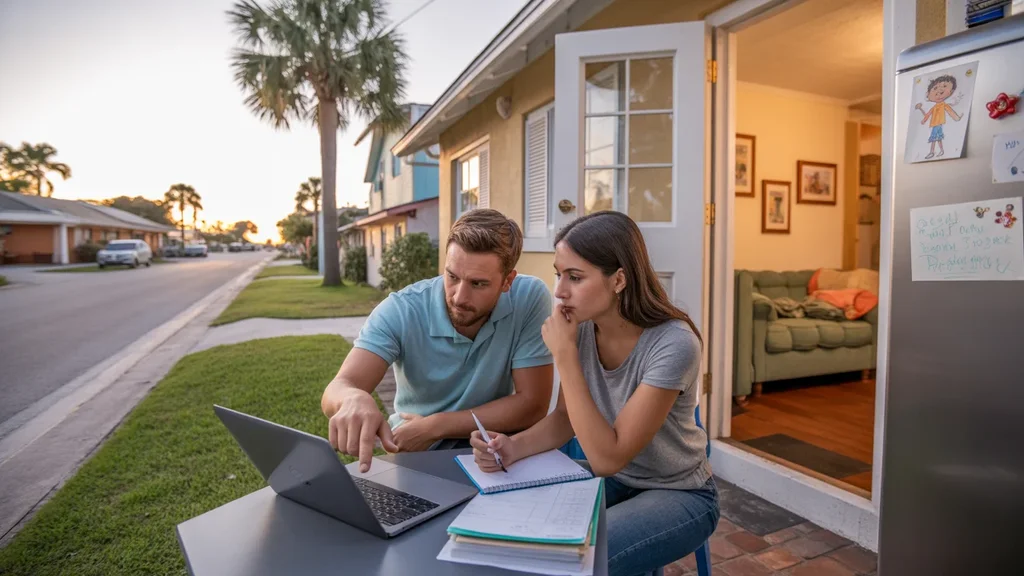It’s a typical Saturday morning in Tampa’s Seminole Heights neighborhood. Jasmine, a 27-year-old remote worker, walks her rescue dog past colorful bungalows and new townhomes. She mentally calculates last month’s expenses, hoping her $3,000 gross monthly income covered rent, utilities, and her weekly trips to the indie coffee shop on Florida Ave. Budgeting is a balancing act in Tampa, where housing and electricity often make up more than 55% of a household’s budget.
Whether you’re a young professional like Jasmine, a dual-income couple, or a family of four, understanding how expenses typically break down is key to managing your monthly budget in Tampa. In this article, we’ll explore real-world examples across different household types and share tips for stretching your dollars further in the Big Guava.
What Real Budgets Look Like in Tampa
To paint a clearer picture of monthly spending in Tampa, let’s look at three common scenarios:
| Expense | Jasmine Single Renter $3,000/mo | Sam & Elena Dual-Income Renters $7,000/mo | The Ortiz Family Homeowners, 2 Kids $9,500/mo |
|---|---|---|---|
| Rent/Mortgage | $1,300 | $2,200 | $2,850 |
| Utilities | $180 | $280 | $450 |
| Food | $400 | $800 | $1,200 |
| Transportation | $120 | $500 | $800 |
| HOA/Fees | $0 | $200 | $350 |
| Miscellaneous | $500 | $1,200 | $1,850 |
| Savings | $500 | $1,820 | $2,000 |
| Total | $3,000 | $7,000 | $9,500 |
These estimates reflect common lifestyle costs in Tampa. Note that all income figures are expressed as gross monthly income (pre-tax). Housing costs in Tampa vary by type, with the median rent for a 1BR apartment around $1,400 and the median mortgage payment for a single-family home closer to $1,800.
Biggest Cost Drivers

In Tampa, keeping cool is a year-round necessity, which means air conditioning can eat up a significant portion of your utility budget. Expect to pay anywhere from $80-$200+ per month for electricity alone, depending on the size of your home and your thermostat settings.
Many Tampa neighborhoods and suburbs also come with HOA fees, which can range from $200-$500 per month. These fees often cover amenities like community pools, fitness centers, and landscaping.
For those who commute by car, transportation costs can add up quickly in Tampa. Between gas, insurance, and maintenance, budget at least $300-$500 per month if you rely on a personal vehicle. Public transportation in Tampa is limited, but can be a more affordable option for those who live and work along bus or streetcar routes.
Tips to Stretch Your Budget Further
While Tampa’s cost of living is relatively affordable compared to other major metros, there are still ways to make your monthly budget go further:
- Shop at discount grocery stores like Aldi or Save A Lot
- Take advantage of off-peak electricity rates if your utility offers them
- Install energy-efficient windows, insulation, or a smart thermostat to lower cooling costs
- Consider biking or carpooling to work to save on gas and parking
🏆 Tip: Check for utility rebates in Tampa to offset the cost of energy-saving upgrades.
FAQs About Monthly Budgets in Tampa
Can you live in Tampa on $3,000/month?
Yes, it’s possible to live comfortably in Tampa on a $3,000 monthly budget, especially if you’re single and don’t mind having a roommate or living in a smaller space. Stick to your budget for housing, utilities, and food, and you’ll have room for some savings and discretionary spending.
What’s a realistic rent budget for Tampa?
Aim to spend no more than 30% of your gross income on rent in Tampa. For example, if you earn $5,000 per month, look for rentals priced at $1,500 or less. Keep in mind that you may need to pay for utilities, parking, or pet rent on top of your base rent.
What’s a good budget for $4,000/month in Tampa?
With a $4,000 monthly budget in Tampa, you could comfortably afford a 1BR apartment ($1,200-$1,500), utilities ($150-$200), groceries ($400-$500), transportation ($200-$300), and have some room for dining out, entertainment, and savings.
Planning Your Next Step
Whether you’re considering a move to Tampa or already call the city home, it’s important to assess your own cost breakdown and see how it aligns with your income and goals. Use these sample budgets as a starting point, but remember that everyone’s situation is unique.
For more insights on the cost of living in Tampa, check out our guides on housing, food, utilities, and other hidden costs of living in the Sunshine State’s third-largest city.
